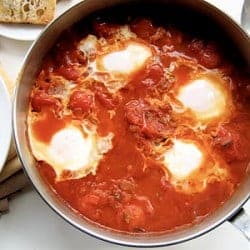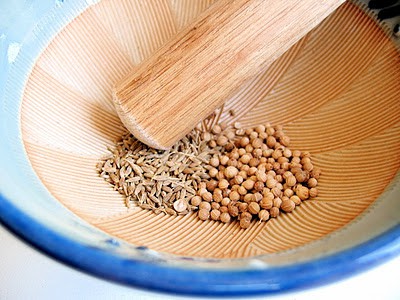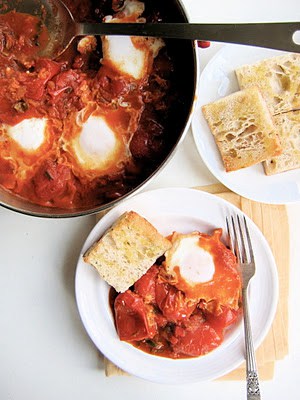
As a child, one of the first big words I learned to spell was 'onomatopoeia,' which means 'a word that sounds like what it means.' 'Crunch,' 'sizzle,' and 'squawk' are all onomatopoeia (but not, ironically, onomatopoeia).
I've been thinking about onomatopoeia lately, because we have been enjoying shakshouka for breakfast, and if there were a classification for a word that sounds the way it tastes, shakshouka would be one of them.
I learned about shakshouka, a Tunisian/Israeli dish of tomatoes stewed with spices and poached eggs,several years ago via an article in the New York Times food section on middle eastern cuisine. The intriguing photograph of a small saute pan filled with tomato goo and an egg that had been cracked and cooked right in the mixture had me reading through the ingredient list, full of fresh tomatoes and peppers, for the next several summers whenever a box would show up.
But I couldn't seem to get past a couple of things:
- The shakshouka called for 5 tablespoons of olive oil -- and claimed to serve one.
- The recipe asked for both canned and fresh tomatoes. During tomato season, why would one use canned? And during non-tomato season, one could not use both. Hence the conundrum.
But The Sunset Cookbook saved my shakshouka experience as their (not entirely traditional) recipe took care of these problems. They scaled the olive oil back to less than 1 tablespoon per serving, and called for only fresh tomatoes, plus a little tomato paste (which, for some reason, seems kosher to use during fresh tomato season, though canned tomatoes do not).
So why does shakshouka sound the way it tastes? (Or does it taste the way it sounds?)
First, cumin, coriander and a large amount of sweet paprika are crushed together in a mortar. (I rejoiced at a chance to use the brick-red paprika a friend brought me from Hungary. Thanks, Kelly!) Then onions get sauteed with sweet and spicy peppers until golden and tender. The spices are added, along with garlic, tomato paste and halved tomatoes, and the tomatoes stew in their juices until soft and infused with the flavors of the spices. Divots are made in the tomatoes, and whole eggs are cracked right in. The pot is covered, and the eggs poach right in the sauce. Crusty bread sops up the sauce nicely; I especially liked Acme's herb slab, a focaccia-like bread flavored with rosemary. Olive oil lovers will appreciate an extra drizzle over the finished dish, and we blasphemed one morning by adding a crumble of fresh goat cheese over the top.
Shakshouka's soft texture and warm spices enrobe the mouth like wrapping oneself in blankets of warm velvet, just the way 'shakshouka' sounds, akin to a romantic whisper. It feels so right on an early fall morning; one of those recipes that bridges the gap between the seasons, both invigorating and comforting at the same time.
The version I made with dry-farmed tomatoes broke down into more of a thick sauce and tasted especially rich and flavorful, while the one made with san marzanos held its shape better and looked a bit more pleasing aesthetically, but had a lighter flavor; so the choice is yours.We like our egg yolks soft but not overly-runny; feel free to leave yours gooier, if you like.
And don't worry if you're not so good at spelling; unlike 'onomatopoeia,' 'shakshouka' (or 'shakshuka') has several options.
More Tomato Recipes:
- Smoky Tomato Butterbean Soup
- Summer Veg Crustless Skillet Quiche
- Tomato-Zucchini Tart
- Tomato Baked White Beans with Feta and Lemon Parsley Oil
*Bojon appétit! For more Bojon Gourmet in your life, follow along on Instagram, Facebook, or Pinterest, purchase my gluten-free cookbook Alternative Baker, or subscribe to receive new posts via email. And if you make this shakshouka recipe, I’d love to know. Leave a comment and rating below, and tag your Instagram snaps @The_Bojon_Gourmet and #bojongourmet.*

Shakshouka
Print Recipe Pin RecipeIngredients
- 2 tablespoons extra-virgin olive oil, plus more for drizzling
- 1 small yellow onion, diced
- 1 jalapeño or poblano pepper, seeds and ribs removed, finely chopped
- 1 sweet red pepper, seeded and chopped (such as bell, gypsy, or corno di toro)
- 1 1/2 teaspoons coriander seed
- 1 teaspoon cumin seed
- 3 large cloves garlic, peeled
- 1/2 teaspoon salt, plus more for sprinkling
- 1 1/2 tablespoons sweet paprika (Spanish or Hungarian)
- 2 tablespoons tomato paste
- 1 1/2 pounds tomatoes (see note)
- water
- 4 eggs
- black pepper
- crusty bread, for serving
Instructions
- In a wide skillet (one that has a tight-fitting lid), warm the oil over medium heat. Add the onion and peppers, and saute until very tender and golden, stirring occasionally 10-15 minutes.
- Meanwhile, crush the coriander and cumin seed in a mortar. Add the garlic and salt, and mash to a paste. Work in the paprika. Set aside.
- Prepare the tomatoes while the onions continue to cook. Halve the tomatoes and cut or squeeze out the seeds and core into a strainer set over a bowl to catch the juices. Press on the solids to extract as much juice as possible, then add enough water to make 3/4 cup of liquid.
- When the onions and peppers are cooked, stir in the spice mixture. Cook 1 minute, then add the tomato paste and work in. Add the juice/water mixture to deglaze, then add the tomatoes and sprinkle with a bit of salt. Cook the tomatoes until soft, turning occasionally, 10-20 minutes, adding a splash more water if the pan is looking dry; it should be thickly saucy.
- When the tomatoes are cooked to your liking, make 4 divots in the tomatoes and crack an egg into each divot. Cover the pot and let the eggs cook for about 5 minutes, until the whites are set but the yolks are still soft.
- Sprinkle the eggs with a bit more salt and a good grind of black pepper. Spoon the tomatoes and eggs onto plates or bowls and serve immediately with crusty bread drizzled with super-good olive oil.
Notes
Nutrition
Shakshouka
Adapted from The New York Times and The Sunset Cookbook
Serves 2-4
This recipe is all about the tomatoes, so use the best you can find. I like dry-farmed early girls the best for flavor, but san marzanos and romas hold their shape better, so the choice is yours. Be sure to have some crusty bread on hand to mop up the saucy juices. It isn't traditional, but we liked this with a crumble of fresh goat cheese over the top.
2 tablespoons extra-virgin olive oil, plus more for drizzling
1 small yellow onion, diced
1 jalapeño or poblano pepper, seeds and ribs removed, finely chopped
1 sweet red pepper (such as bell, gypsy, or corno di toro), seeded and chopped
1 1/2 teaspoons coriander seed
1 teaspoon cumin seed
3 large cloves garlic, peeled
1/2 teaspoon salt, plus more for sprinkling
1 1/2 tablespoons sweet paprika (Spanish or Hungarian)
2 tablespoons tomato paste
1 1/2 pounds tomatoes (see headnote)
water
4 eggs
black pepper
crusty bread, for serving
In a wide skillet (one that has a tight-fitting lid), warm the oil over medium heat. Add the onion and peppers, and saute until very tender and golden, stirring occasionally 10-15 minutes.
Meanwhile, crush the coriander and cumin seed in a mortar. Add the garlic and salt, and mash to a paste. Work in the paprika. Set aside.
Prepare the tomatoes while the onions continue to cook. Halve the tomatoes and cut or squeeze out the seeds and core into a strainer set over a bowl to catch the juices. Press on the solids to extract as much juice as possible, then add enough water to make 3/4 cup of liquid.
When the onions and peppers are cooked, stir in the spice mixture. Cook 1 minute, then add the tomato paste and work in. Add the juice/water mixture to deglaze, then add the tomatoes and sprinkle with a bit of salt. Cook the tomatoes until soft, turning occasionally, 10-20 minutes, adding a splash more water if the pan is looking dry; it should be thickly saucy.
When the tomatoes are cooked to your liking, make 4 divots in the tomatoes and crack an egg into each divot. Cover the pot and let the eggs cook for about 5 minutes, until the whites are set but the yolks are still soft.
Sprinkle the eggs with a bit more salt and a good grind of black pepper. Spoon the tomatoes and eggs onto plates or bowls and serve immediately with crusty bread drizzled with super-good olive oil.















Anonymous says
WOW. My mouth is watering. Or, really in layman's terms, I'm drooling... All over my keyboard. Sorry, TMI.
Shu Han says
THAT. LOOKS. SO. GOOD. even though I can't pronounce the word.
Alanna says
Thanks, guys!
Stan says
This was a wonderful way to finish off the last of this years pitiful crop of heirlooms! The goat cheese may not be traditional, but it worked well for us too. Thanks Alanna!
Alanna says
Right on, Stan!